Rajasthan Board RBSE Class 11 Physics Chapter 5 Work, Energy and Power
RBSE Class 11 Physics Chapter 5 Very Short Answer Type Questions
Question 1.
What would be the work done by a man against the gravity, if he is walking on a plane road?
Answer:
By the formula of work
W = Fd cosθ
The angle between weight force and displacement on a plane road is 90°
∴ W Fd cos 90 = 0
Question 2.
A man carries a mass of 10 kg for 10 min on his shoulders. How much is the work done by the man?
Answer:
By the same solution as that of question
Question 3.
A man lifts a bo× to the roof of the bus in 5 min. While another man lifted it in 2 min. Who did more work?
Answer:
Both have done the same work. By the relation
W = mgh
Question 4.
A truck and a car are moving with the same kinetic energy on a straight road. Their engines are simultaneously turned off. Which one will stop at a lesser distance?
Answer:
Tuck
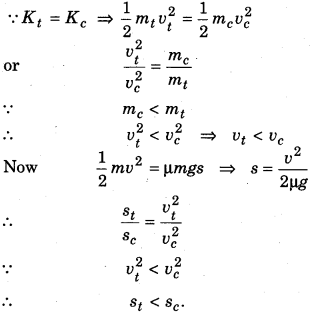
Question 5.
A man lifted and put a bo× on the roof of the bus at a height h from Earth. What is the total work done on the bo× by the man and the gravitational field?
Answer:
Zero,
The work done by the man on the box,
W1 = mgh
and the work done on the bo× by gravitational field,
W2 = -mgh
∴ Total work done on the box,
W = W1 + W2 = mgh – mgh = 0
or W = 0 (zero)
Question 6.
Is mechanical energy always conserved?
Answer:
No, mechanical energy is conserved for is dated system only when internal non-conservative force is zero.
Question 7.
Which energy is stored in the spring while winding a clock? In which energy it gets converted when the clock is working?
Answer:
Potential energy; Kinetic energy.
Question 8.
Can kinetic energy be changed without changing the momentum of system?
Answer:
Yes; the total momentum of all particles of the system will remain unchanged but their individual momentum may change and hence kinetic energy may change.
Question 9.
Can the momentum of a particle be changed without changing its kinetic energy?
Answer:
Yes, in uniform circular motion, The velocity changes every moment and hence the momentum changes every moment.
Question 10.
Can whole of the kinetic energy be lost in a completely inelastic collision?
Answer:
Yes, if the total momentum of particles before collision is zero.
Question 11.
How are the velocities of the particles of same mass related when they collide in a linear elastic collision?
Answer:
After collision, the velocities of the particles are interchanged.
RBSE Class 11 Physics Chapter 5 Short Answer Type Questions
Question 1.
What is work?
Answer:
Work: When an object is displaced in influence of a force, then the. dot product of force and displacement provides the work done, i.e,
\(W=\vec{F} \cdot \vec{d}=F d \cos \theta\)
Question 2.
Give examples of zero work, positive work and negative work.
Answer:
Zero work: ∵ W = Fdcosθ
If θ = 90°, then cosθ = 0, therefore W = 0
For example- work done by centripetal force in uniform circular motion is zero.
Positive work:
Again W = Fd cosθ
When θ is less than 90°, then cosθ is positive, and hence the work done will be positive.
e.g. when 0 = 0°, then cos0 = 1 then W = Fd.
For example: When a man lifts a weight upwards, then the work done by the man is positive.
Negative work: When θ = 180°, then cosθ = -1, then W is negative.
For example: When a man lifts a weight, the work done by the gravitational force is negative.
Question 3.
A bullet is fired from gun. Which one-gun or bullet-will have more kinetic energy?
Answer:
\(\because E_{k}=\frac{p^{2}}{2 m} \text { or } E_{k} \propto \frac{1}{m} \text { if } p\) is constant.
∵ The momentum of bullet and the gun is same, and the mass of bullet is less than that of the gun. Hence the kinetic energy of the bullet will be greater than that of the gun.
Question 4.
What is kinetic energy?
Answer:
The energy which is due to motion of a particle is known as its kinetic energy. The measurement of kinetic energy of a particle is done by the work done required to take the particle from zero velocity to the state of that velocity.
Question 5.
Write the main properties of potential energy.
Answer:
- The energy possessed by a body by virtue of its position or configuration is called the potential energy.
- When the position of an object or body or system changes, the potential energy changes and it converts into another form of energy.
Question 6.
Define conservative forces.
Answer:
Conservative forces: A force is said to be conservative if the work done by or against the force is dependent only on the initial and final positions of the body and not on the path followed by the body.
For example: If initial position of the body is A and final position is B, then for conservative force.
\(W_{A B}=W_{A C B}=W_{A D B}\)
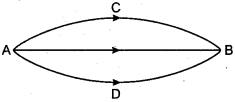
Question 7.
If the momentum of a body is increased by 50%, then how much would the kinetic energy increase?
Answer:
The relation between kinetic energy and momentum,
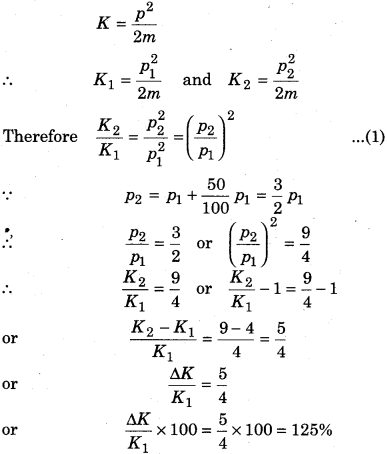
∴ Percentage increase in kinetic energy = 125%
Question 8.
What is a two-dimensional collision?
Answer:
When initial and final velocities lie in a plane, it is called two-dimensional collision. It is also called oblique collision. In following diagram, the two-dimensional collision of two bodies is shown in a given figure.
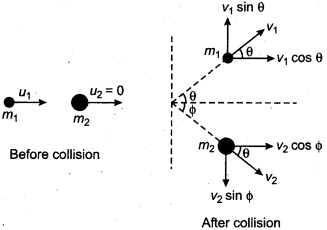
RBSE Class 11 Physics Chapter 5 Long Answer Type Questions
Question 1.
What is work? How do we find the work done by the variable forces? Explain.
Answer:
Work
In common language, work is a word defining any action in which physical labour is involved. But the definition changes in Physics. If force is applied on anybody and that body is displaced in the direction of the applied force, then it is said to be work is done.
(a) Work Done by Constant Force
For doing work always force is required. When force applied on any object it changes the position of

the object. Then work done is defined as the product of the component of force in the direction of the displacement and the displacement; or vice versa, i.e
Work = Force × Displacement in the direction of force.
If the applied force on a body is F then the body is displaced from the position A to position Band d is the displacement then the work done in: W=Fd
Unit and dimensional formula:
∴ W=Fd
∴ Unit of work = Nm = Joule (J)
IfF=1N, d=lmthenW=1J
Hence the applied force on the body is 1 Newton and body is displaced 1 meter due to this force, then the work is said to be one joule.
∵ W=Fd
∵ Dimensional formula of work
= [M1L1T-2] [L]
= [M1L2T-2]
(b) Work Done by Constant Force Acting at an Angie e Suppose an object (a body) is kept on a horizontal plane. A force F i8 applied at an angle θ from the horizontal on the body; which displaces the body on the horizontal plane from position A to R The distance from A to B is d. The displacement generated is due to the horizontal component Fcos θ. Hence, the work done is:
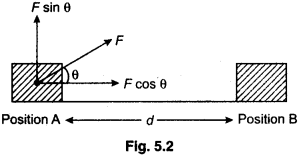
W = Force x Displacement in the direction of force
=Fcosθ × d
or W = Fdcosθ
or \(W=\vec{F} . \vec{d}\)
i.e., Scalar product of force and displacement provides work.
Work Done by the Variable Force
In the position of the variable force; suppose the work done at point P by a force \(\vec{F}\) and displacement \(\vec{dr}\) is
\(\begin{aligned} d W &=\vec{F} \cdot \vec{d} r \\ \text { or } & d W=F d r \cos \theta \end{aligned}\)
Here, e is the angle between \(\vec{F}\) and \(\vec{dr}\) at point P.
The value of \(\vec{dr}\) is infinitely small.
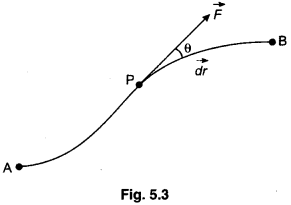
Hence, work done for infinitely small displacement dr is dW.
Similarly, to calculate the work done for complete distance A→b R, the total distance is divided into \(\Delta \vec{r}_{1}, \Delta \vec{r}_{2}\) …………. These should be so small that the force relative to them can be considered constant. If the forces relative to these are \(\vec{F}_{1}, \vec{r}_{2}, \vec{r}_{3}\) ……………….. respectively, then work done in the total displacement:
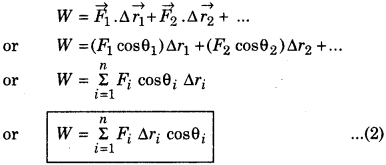
The total work done is given mathematically as;

Calculation of Work Done by The Force-Displacement Graph
For calculation of work done by graphical procedure it is assumed that the force and displacement are in the same directions. Suppose, the change in force with the displacement (from A to B) is same as in fig 5.4. The initial position of the body is r1 and final position ìs r2.
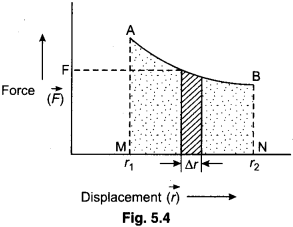
The distance r is assumed to be made of various small elements dr1, dr2 ,dr3, ………….. etc. The force component can be assumed to have a constant value Δr for displacement Δr. Thus, total work done will be;
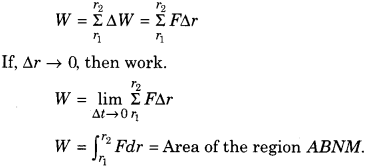
Thus, the work done by the force can be determined by measuring the area between the curve and the displacement axis.
Question 2.
What is kinetic energy? Prove that the kinetic energy of a body is \(\frac{1}{2} m v^{2}\) Derive the relation for work-energy theorem while explaining it.
Answer:
Kinetic Energy and Potential Energy
Kinetic Energy
The energy associated with the motion of an object is called kinetic energy. For example, the motion of a falling stone, motion of a car, etc. The kinetic energy of an object is a measure of the work that an object can do by the virtue of its motion.

Consider a body having mass m initially at rest (u = 0);initial velocity u = 0. Let a constant force Facts on a body due to which it gains a velocity v after travelling a displacement s. Then, kinetic energy of the body;
K = W = Fs ………………………….(1)
By Newton’s law of motion
F = ma ………………….(2)
From the third equation of motion
\(\begin{array}{l}{v^{2}=u^{2}+2 a s} \\ {v^{2}=(0)^{2}+2 a s} \\ {s=\frac{v^{2}}{2 a}}\end{array}\)
from the equation (1), (2) and (3)
\(\therefore \qquad K=W=\max \frac{v^{2}}{2 a}\)
\(K=W=\frac{1}{2} m v^{2}\)
Potential Energy
The energy possessed by a body by virtue of its position or configuration is called the potential energy (JJ). When the position of an object or body or system changes, the potential energy changes and it converts into another form of energy.
A body kept at certain height has potential energy because when it is released, it provides motion to the body. The ability of a body kept at certain height of doing work by providing motion to the body is potential energy. When the body is released it acquires velocity. This means that it gains kinetic energy.
The gravitational force on a ball having mass m is mg. Let us raise the ball to a height h. Then, the work done by the external agent is mgh. This work gets stored as potential energy. So, the potential energy is (u).
U = W = mgh
Work-Energy Theorem Statement:
According to a work-energy theorem, the amount of work done by the net force acting on a body is equal to the change in kinetic energy. If the body is in motion. Mathematically, we write it as:
W = Kf – Ki – ΔK
Suppose a particle of mass m moving with a velocity u at any instant . Let a force \(\vec{F}\) be acting on the body due to which its elocity is \(\vec{u}\) after travelling a distance \(\vec{S}\) and the acceleration produced is a, then according to Newton’s third equation of motion;
\(\begin{aligned} v^{2} &=u^{2}+2 \vec{a} \vec{s} \\ \text { or } \quad v^{2}-u^{2} &=2 \vec{a} \vec{s} \end{aligned}\)
Multiplying the above equation with \(\frac{1}{2} m\).
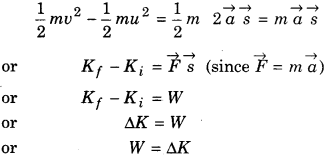
Hence, it is clear that the work done by the net force applied on a body is equal to the change in the kinetic energies of the body in two different situations. This is a work-energy theorem. Hence, it is clear that:
(i) \(W>0 \text { then }\left(K_{f}-K_{i}\right)>0 \text { or } K_{f}>K_{i}\) i.e., if work done is positive then final kinetic energy is more than initial kinetic energy.
(ii) \(W<0 \text { then }\left(K_{f}-K_{i}\right)<0 \text { or } K_{f}<K_{i}\) i.e., if work done is negative then final kinetic energy is less than initial kinetic energy.
Work energy theorem by calculus method :
Let the force (F) is applied on a body then the body is displaced at d× in the direction of force :
∴ Small work done = force × displacement
dW = Fd×
for total work done
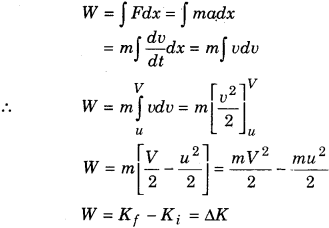
Potential Energy of a Spring
An idealized spring exerts a force that is proportional to the amount of deformation of the spring from its equilibrium length; exerted in a direction opposite to the deformation. Pulling the spring to a greater length causes it to exert a force that brings the spring back towards its equilibrium length. The amount of force can be determined by multiplying the spring constant of the spring by the amount of stretch.
This opposite force is called ‘restoring force’. Restoring force is a force that gives rise to an equilibrium in a physical system. The force law for spring is called the Hooke’s law. If the restoring force
is \(\vec{F}_{s}\) and displacement is \(\vec{x}\) then;
\(\begin{array}{l}{\vec{F}_{s} \propto-\vec{x}} \\ {\text { or } \quad \vec{F}_{s}=-k \vec{x}}\end{array}\) ……………….(1)
Where k is a constant which is called the force constant of the spring.
The negative sign in Eq. (1) shows that the restoring force i.e., the spring force (Fig. 5.6) is opposite to the displacement \(\overrightarrow{(x)}\). The unit of k from equation (1) is Nm-1
In equilibrium state the value of restoring force is calculated by external force. Hence, if external force is \(\vec{F}\) then;
\(F=-\vec{F}_{s}\)
∴ The form of eq. (1) will be as follows :
\(\begin{array}{l}{\vec{F}=k \vec{x}} \\ {\vec{F} \propto \vec{x}} \\ {F \propto x}\end{array}\) ………………….(2)
Hence, graph between F and × will be a straight line as shown in fig. 5.6.
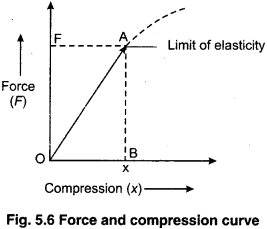
Hence, from graph work done in giving a displacement × to the spring is;
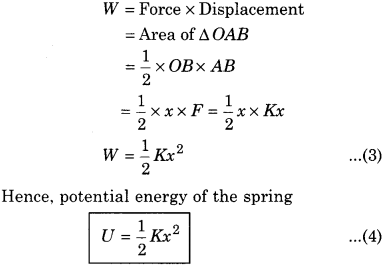
Law of Conservation of Mechanical Energy
‘The mechanical energy of any body or a system i. e., the sum of its kinetic energy and potential energy is constant in the presence of conservative forces.’ This is called the law of conservation of mechanical energy.
We clearly know that when conservative forces one applied on a system, its configuration changes and the kinetic energy of this system changes by AK. According to the definition of conservative force there should be a change equal in magnitude in the potential energy of the system but in opposite direction. Due to which the sum of both the changes becomes zero, i. e.,
\(\begin{aligned} \Delta U &=-\Delta K \\ \text { or } \quad \Delta U+\Delta K &=0 \\ \text { or } \quad U+K &=\text { constant } \end{aligned}\)
= constant ………………………(1)
Hence, in the presence of the conservative forces, the change in the kinetic energy (K) is equal and opposite to the change in the potential energy (U). Due to this the sum of the kinetic energy and potential energy is always constant.
This law is not true for non-conservative forces like-frictional force because some part of the non-conservative forces changes into the sound, heat, light and other types of energies.
Some Examples of Law of Conservation of Mechanical Energy:
Example: Free Falling Body : Fig 5.7 shows a free falling body of mass m in the effect of gravitational force (conservative force). The height of point A from the earth’s surface is h; and the velocity of the object at A is zero (u = 0). Calculate the total mechanical energy of the system at A

When the body falls freely for a height × and reaches B then;
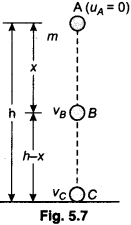

∴ Total mechanical energy B

Similarly, at a point C on the earth’s surface
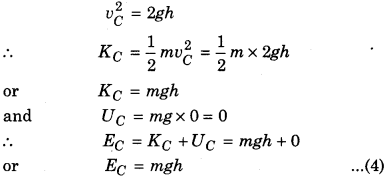
It is clear from the eqs (2), (3) and (4) that;
EA = EB = EC = mgh
Clearly, as the body falls, it’s potential energy decrease uniformly such that it’s total mechanical energy remains constant (mgh) at all point. Thus total mechanical energy is conserved during free fall of a body. Fig. 5.8 shows the variation of KE and PE and the total mechanical energy (TME) with height
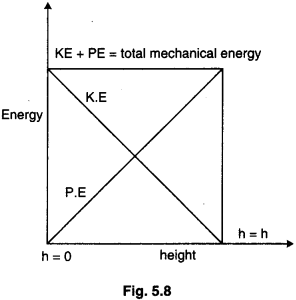
The relation between Linear Momentum and Kinetic Energy
We know that;
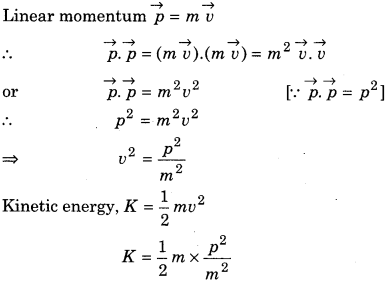

Eqs (1) and (2) show the relationship between linear momentum and kinetic energy. It is also clearly shown from these equations that without kinetic energy linear momentum is not possible and without linear momentum, kinetic energy is not possible.
Special Cases:
- If mass m is constant then \(p \propto \sqrt{K}\) i.e., for equal masses the object with more kinetic energy will have more linear momentum.
- If momentum p is constant then \(K \propto \frac{1}{m}\) i.e., for constant momentum of bodies, the one with minimum mass will have maximum kinetic energy.
- If kinetic energy is constant then linear momentum \(p \propto \sqrt{m}\) i. e., the body with maximum mass will have maximum linear momentum.
Question 3.
Define energy and explain the different forms of energy.
Answer:
Energy and Types of Energy
Energy is a famous word meaning without energy no work is possible. Humans can gain energy by eating food, drinking milk, eating fruits, vegetables, etc.
Energy of a body is the ability to do work. The energy of a body is measured by the work done by body.
When a body or an object does work its energy decreases. The energy of a body is calculated by its ability to do work.
As energy is explained in terms of work: it has the same unit as that of work: i.e., joule. The other units of energy are kilowatt-hour (kWh) and electron volt (eV).
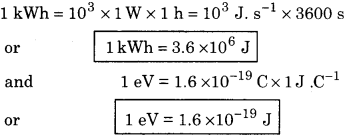
Types of Energy
There are various types of energy like mechanical energy, internal energy, electrical energy, solar energy, light energy, chemical energy, nuclear energy, etc. Due to the various incidents happening in nature energy gets converted from one form to another.
- Sound energy: This is the type of energy that causes the sensation of hearing is us. Sound energy is the vibration energy caused by the propagation of sound in the medium.
- Chemical energy: Chemical energy is produced by the different binding energies of the molecules participating in the chemical reaction.
- Light energy: This is the type of energy that causes the sensation of sight in us.
- Solar energy: The energy obtained from the sun is called solar energy.
- Nuclear energy: The energy due to the nuclear forces acting between the nuclei of the nuclear particles is called nuclear energy.
Nuclear energy is of two types :
- Nuclear fission
- Nuclear fusion
In nuclear fission when slow-moving neutrons attack U235, then the nucleus splits into lighter nuclei. The final mass is less than the initial mass. This mass difference translates into energy. This energy can be tapped to provide electrical energy.
In nuclear fusion, lighter nuclei fuse to form a heavy nucleus whose mass is less than the sum of the masses of the reactants. It is stated by Einstein’s mass-energy relationship :
E = me2.
Where, m = mass difference/mass defect, c = speed of light, E = energy.
6. Mechanical energy: A body can possess energy due to motion or due to change in position. The energy possessed due to above-stated conditions is called mechanical energy. For example the energy of water in a water tank placed on terrace, energy of a moving bullet, energy of a small spring in a ball pen, etc.
The above examples of mechanical energy make it clear that mechanical energy is of two types :
- Kinetic energy
- Potential energy.
7. Internal energy: Every substance is made up of atoms. Due to irregular motion of atoms in liquids and gases and vibration motion of atoms in solids, they have kinetic energy. This is called the internal kinetic energy of the particle. Due to attractive forces between the atoms they also have internal potential energy. The sum of internal kinetic energy and internal potential energy is called internal energy. Internal kinetic energy is dependent on the temperature of the substance whereas internal potential energy is dependent on the distance between the atoms. It is clear that the change in any one of the above would bring a change in internal energy.
Question 4.
What is the law of conservation of mechanical energy? Prove that mechanical energy is conserved for a freely falling body.
Answer:
Law of Conservation of Mechanical Energy
‘The mechanical energy of any body or a system i. e., the sum of its kinetic energy and potential energy is constant in the presence of conservative forces.’ This is called the law of conservation of mechanical energy.
We clearly know that when conservative forces one applied on a system, its configuration changes and the kinetic energy of this system changes by AK. According to the definition of conservative force there should be a change equal in magnitude in the potential energy of the system but in opposite direction. Due to which the sum of both the changes becomes zero, i. e.,
\(\begin{aligned} \Delta U &=-\Delta K \\ \text { or } \quad \Delta U+\Delta K &=0 \\ \text { or } \quad U+K &=\text { constant } \end{aligned}\)
= constant ………………………(1)
Hence, in the presence of the conservative forces, the change in the kinetic energy (K) is equal and opposite to the change in the potential energy (U). Due to this the sum of the kinetic energy and potential energy is always constant.
This law is not true for non-conservative forces like-frictional force because some part of the non-conservative forces changes into the sound, heat, light and other types of energies.
Some Examples of Law of Conservation of Mechanical Energy:
Example: Free Falling Body : Fig 5.7 shows a free falling body of mass m in the effect of gravitational force (conservative force). The height of point A from the earth’s surface is h; and the velocity of the object at A is zero (u = 0). Calculate the total mechanical energy of the system at A

When the body falls freely for a height × and reaches B then;
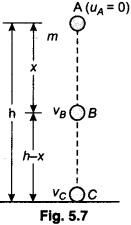

∴ Total mechanical energy B

Similarly, at a point C on the earth’s surface
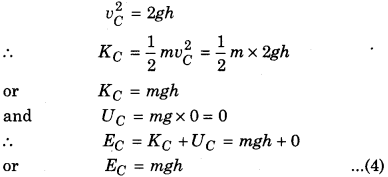
It is clear from the eqs (2), (3) and (4) that;
EA = EB = EC = mgh
Clearly, as the body falls, it’s potential energy decrease uniformly such that it’s total mechanical energy remains constant (mgh) at all point. Thus total mechanical energy is conserved during free fall of a body. Fig. 5.8 shows the variation of KE and PE and the total mechanical energy (TME) with height
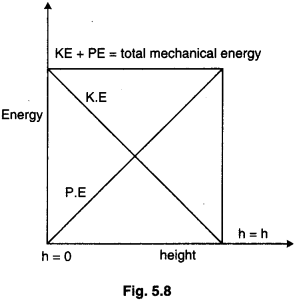
Example 2:
A showing simple pendulum, is an also example of conservation of energy:
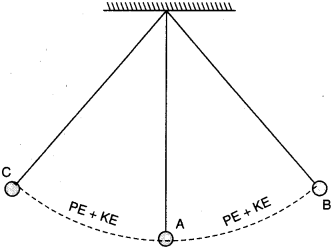
This is because a swinging simple pendulum is a body whose energy can either be potential or kinetic, or a mixture of potential and kinetic but it’s total energy at any instant of time remains the same.
When the pendulum bob is at position B it has only potential energy (but no kinetic energy) As the bob starts moving down from position B to position Ai it’s potential energy goes on decreasing but it’s kinetic energy goes on increasing when the bob reaches the centre position A it has only kinetic energy (but no potential energy)
As the bob goes from position A towards position C, it’s kinetic energy goes on decreasing but its potential energy on increase.
On reaching the extreme position C, the bob stops for a very small instant of time, so at position C, the bob has only potential energy.
Question 5.
Differentiate between elastic, inelastic and completely inelastic collisions. Obtain the formula for the velocities of the particles after collision, undergoing head-on collision (elastic).
Answer:
One Dimensional Elastic Collision
Suppose two bodies of masses m1 and m2 be moving in a straight line with velocities u1 and u2 respectively and collide with each other. Let their velocities after collision he u2 and u2 respectively.

Inelastic collision both momentum and kinetic energy are conserved. Hence, according to the law of conservation of momentum.

According to the law of conservation of kinetic energy,

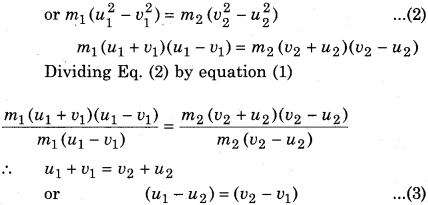
In this way, in a one-dimensional elastic collision, the velocity of approach (u1 – u2) is equal to the velocity of separation (u2 -u1). Hence, the coefficient of restìtutinn is:
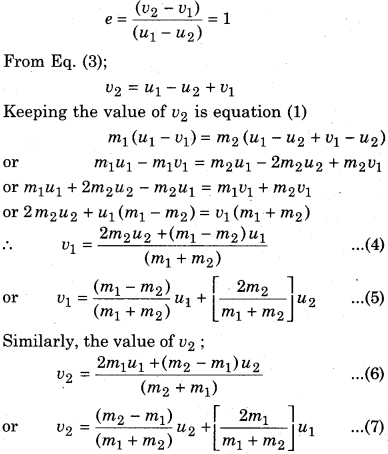
Special Cases:
Case I:
When m1 = m2 = m then from Eq. (5) and (7)
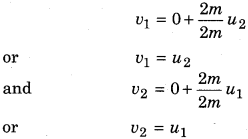
Hence, it is clear that there is exchange of velocities in the elastic collision of same masses.
If u2 = O then u1 = O and u = u1 ………………………..(8)
i. e., if the second particle is in the state of rest then after the collision the first particle will remain at rest and second particle will move with the velocity of the first. In this situation the exchange of velocities in both the particles is maximum.
Case II:
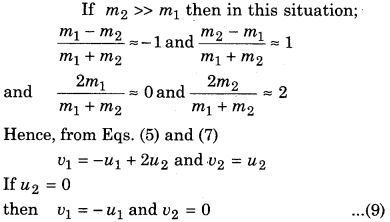
So, the heavier mass is undisturbed while the lighter mass reverses its velocity.
Case III:
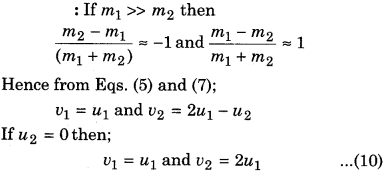
So, the final velocity of the heavier mass is equal to its initial velocity while the lighter mass moves double of its initial velocity.
RBSE Class 11 Physics Chapter 5 Numerical Questions
Question 1.
Earth revolves around the Sun. Calculate the work done by the gravitational force, assuming its path to be circular.
Solution:
∵ Work done
W = Fd cosθ
Assuming the path of the earth around the sun be circular, the angle between gravitation force Fg and velocity (i.e., the displacement), is
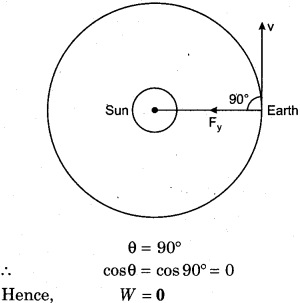
Question 2.
Calculate the work done by the frictional force in pulling a mass of 50 kg for a distance of 100 m on a road. The limiting coefficient of friction for road is, μ8 = 0.2.
Solution:
Given; m = 50 kg;
μ8 = 0.2, d = 100 m
The limiting friction force
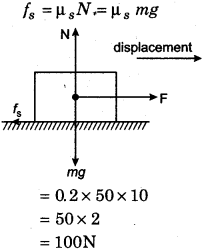
∵ Work done W = Fd cosθ
The angle between frictional force and displacement
θ = 180°
cosθ = cos 180° = -1
And F = fs = 100 N
∴ The work done by force of friction
W = Fd cosθ = 100 × 100 x(-1)
or W=-104 j
Angle between force applied F and displacement,
0 = 0°
∴ cos0 = 1
∴ W = 100 × 100 × 1 = 104 J
or W = 104 J
Question 3.
A man of 60 kg carries a stone of 20 kg to a height of 30 m. Calculate the work done by the man.
Solution:
Given; mass of the man M = 60 kg; mass of the stone m = 20kg; h = 30m; g = 10 ms-2
∴ Total weight carried by the man,
Fg =W = (M + m)g=(60+ 20)× 10 = 800 N
∴ The work done by the man,
W = Fgh = 800 x 30
or W = 24000J
or W = 2.4 × 104 J
Question 4.
A man is carrying a bo× of 2 kg in his hands while moving on a plane. If he moves 40 m with an acceleration of 0.5 ms-2, then calculate the work done on the bo× by the man during the motion.
Solution:
Given; m = 2kg; a = 0.5 ms-2, d = 40m; W = ?
Force applied by the man on the box during accelerated motion,
F= ma = 2×0.5 = 1.0 N v
∵ The directions of force and displacement are the same.
∴ θ = 0
∴ cos0 1
Hence W = Fdcosθ = 1 × 40 × 1
or W = 40 J
Question 5.
A mass of 2.5 kg is hung on a steel wire. This increases 0.25 cm in its length. Determine the work done to pull the wire. (g = 10 m/s2) [Hint: Mg = kx, W = \(\frac{1}{2}\) kx2]
Solution:
Given; F = 2.5 xg = 2.5 × 10 = 25 N
x = 0.25 cm = 0.25 x 10-2 m = 2.5 x 10-3 m
If the force constant of the wire be k, then
\(F=k x \Rightarrow k=\frac{F}{x}=\frac{25}{2.5 \times 10^{-3}}=10^{4} \mathrm{N} \cdot \mathrm{m}^{-1}\)
∴ The work done in pulling the wire,
W = \(\frac{1}{2}\) kx2=\(\frac{1}{2}\) × 104 × 2.5 x 2.5 x 10-6
= \(\frac{1}{2}\) × 6.25 × 10-2
= 3.125 x 10-2 J= 0.03125 J
Question 6.
If on increasing the speed of a vehicle by 2 ms-1, the kinetic energy gets doubled, then what would be its initial speed?
Solution:
Given; Δv = 2 ms-1, K2 = 2K, u = ?
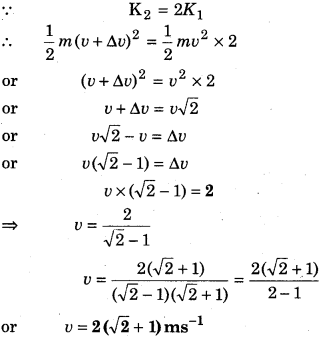
Question 7.
An object of mass of 2 kg falls from aheight of 10 m into the sand. The object moves 2 cm in sand before coming to rest, then what would be the average resistive force?
Solution:
Given; m = 2kg; h = 10m;
s = 2cm = 2 × 10-2 m;F = ?
The final velocity of the object on reaching the sand’s surface:
\(v_{1}=\sqrt{2 g h}=\sqrt{2 \times 9.8 \times 10}=14 \mathrm{ms}^{-1}\)
Initial kinetic energy of the object
K1 = \(\frac{1}{2} m v_{1}^{2}\) mvf = \(\frac{1}{2}\) × 2 × 14 × 14
or K1 = 196 J
The final kinetic energy of the object
K2 = 0
If resistive force be F, then
W = FS
Now using work-energy theorem
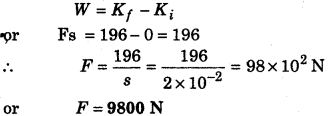
Question 8.
A running man has half the kinetic energy as that of a boy of half his mass. The man speeds up by 1ms-1 so that the kinetic energies of the boy and man are equal. Calculate the initial speeds of boy and man.
Solution:
Suppose the mass of the man = m1 and speed = u1, mass of the boy m2 = m1/n2 and speed =
Given: In the beginning Kman = \(\frac{1}{2}\) kboy

When the speed of man becomes \(\left(v_{1}+1\right)\) then Kman = \(\frac{1}{2}\) kboy

Comparing Eqs (1) and (2), we get
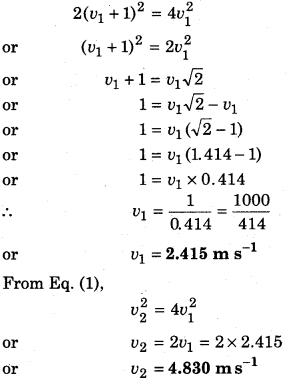
Question 9.
The velocity of a car changes from 40 km h-1 to 60 km h-1. The mass of the car is 1000 kg. Calculate the change in kinetic energy.
Solution:
Given; m = 1000kg;

Change in kinetic energy,
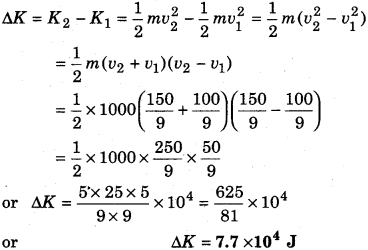
Question 10.
A bullet of gun going horizontal with velocity of 400 m/s embedded in a bag of sand and comes to rest. The masses of bullet and bag respectively 0.025 kg and 1.975 kg. Find out velocity of (bullet + sand). How much loss of kinetic energy is in this process?
Solution:
Given; mass of the bullet m = 0.025 kg and its velocity u = 400ms-1, mass of sand bag M = 1.975 kg; joint velocity u =?
∵ Joint velocity,
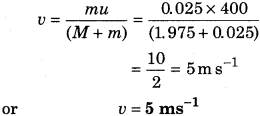
Initial kinetic energy,
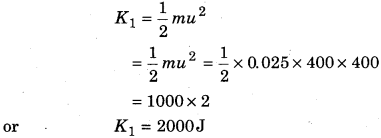
Final kinetic energy

∴ Loss in kinetic energy

Question 11.
A motor lifts 100 L water to a tank 20 m high in 1 min. Calculate the power of motor in watt.
Solution:
The volume of the lifted water
V = 100L = 100 × 10-3 m3
= 0.10m3
The mass of this water
m = Vp = 0.1 × 103 = 102 kg
∴ The total work done by the motor,
W = mgh = 102 × 10 × 20
or W = 2 × 104 J
Since the tine t = 1 min = 60 s
∴ Power of the motor
\(P=\frac{W}{t}=\frac{2 \times 10^{4}}{60}=\frac{1}{3} \times 10^{3}\)
= 0.3333 x 103 watt
or P = 333.3 watt
Question 12.
A stable body of mass 4 m suddenly explodes into three parts. If two parts of mass m moves with velocity v perpendicularly, then find out the velocity of third part of mass 2 m. Find out also the increase in kinetic energy after explosion.
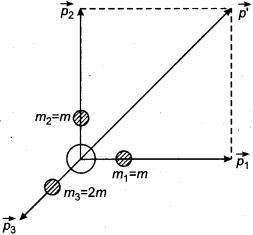
Solution:
Given; m1 = m2 = m; v1 = v2 – v, m3 = 2m; u3 =?
P1 = m1V1 = mv
P2 = m2v2 = mv ,
P3 = m3v3 = 2mv3
As is given in the question that
\(\overrightarrow{p_{1}} \perp \overrightarrow{p_{2}}\)
∴ The resultant moment of these particles

Now according to principle of conservation of momentum.
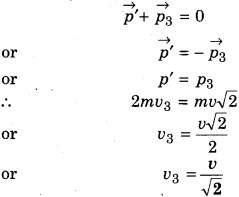
Increase in kinetic energy,
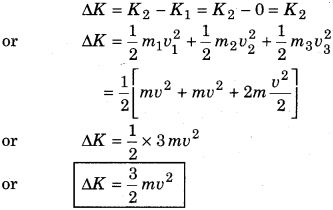
Question 13.
A block of mass 2m moving with a velocity of v collides with a block of mass 4 m, which is at rest. After collision first block comes into rest. Find out the value of the coefficient of restitution.
Solution:
Given; m1 = 2m, u1 = u; m2 = 4m;
u2 = v1 = k u2 = ?; e=?
According to principle of conservation of momentum,
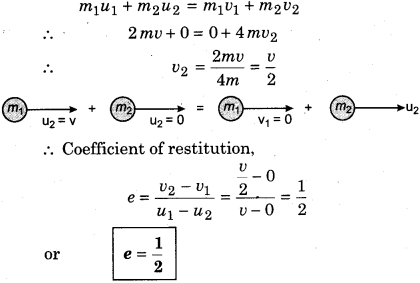
Question 14.
When a U238 nucleus originally at rest, decays by emitting an alpha particle having a speed 1.5 × 107 ms-1. Then, calculate the kinetic energy of the residual nucleus.
Solution:
92U238 → 90Th234 + 2He4 (α-particle)
If mass of one nucleon is m, then according to principle conservation of momentum, Momentum of residual = Momentum of α-particle nucleus

∵ The mass of one nucleon m = 1.67 x 10-27 kg
∴ Mass of Thorium nucleus
\(m_{t h}=234 \times 1.67 \times 10^{-27} \mathrm{kg}\)
∴ Kinetic energy of esidual nucleus,
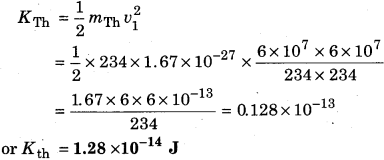
Question 15.
A block of mass 4 kg moving with a velocity of 10 m/s collides elastically with a block of mass 5 kg, which is at rest. If after collision blocks deflected at angle 30° and 60° respectively, then find out the velocities; of the block after collision.
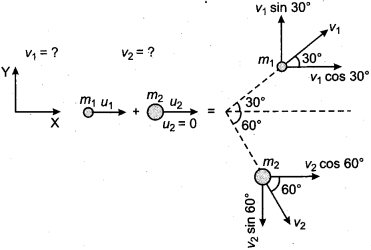
Solution:
Given;
m1 = 4 kg, u1 = 10 ms-1; m2 = 5 kg,
u2 = 0; θ1 = 30°, θ2 = 60°;
u1 = ?; u2 = ?
Applying the law of conservation of momentum in A-direction, we have
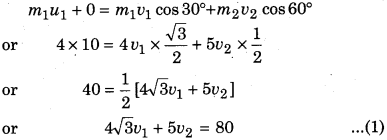
Now applying the law of conservation of momentum in Y-direction, we get
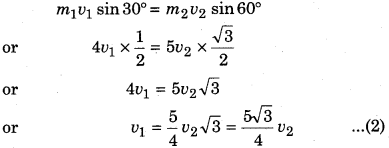
Putting the value of u2 in Eq (1), we get
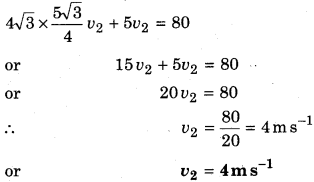
Now substituting the value of v2 in Eq (2), we get
![]()